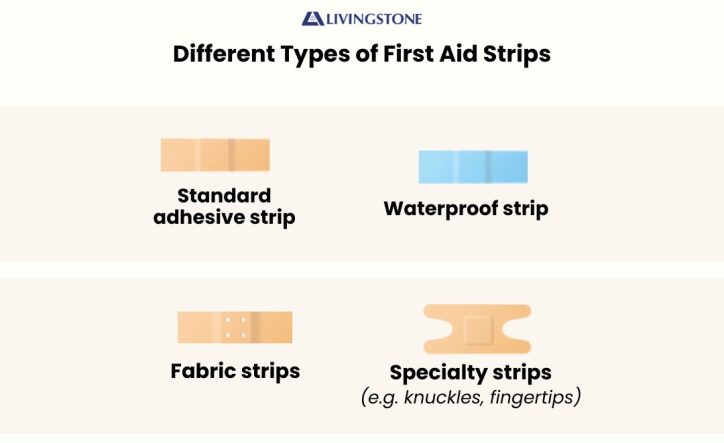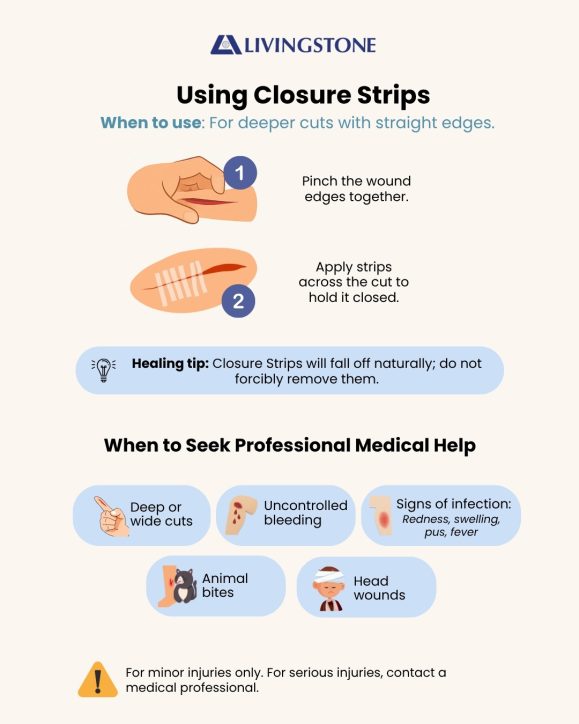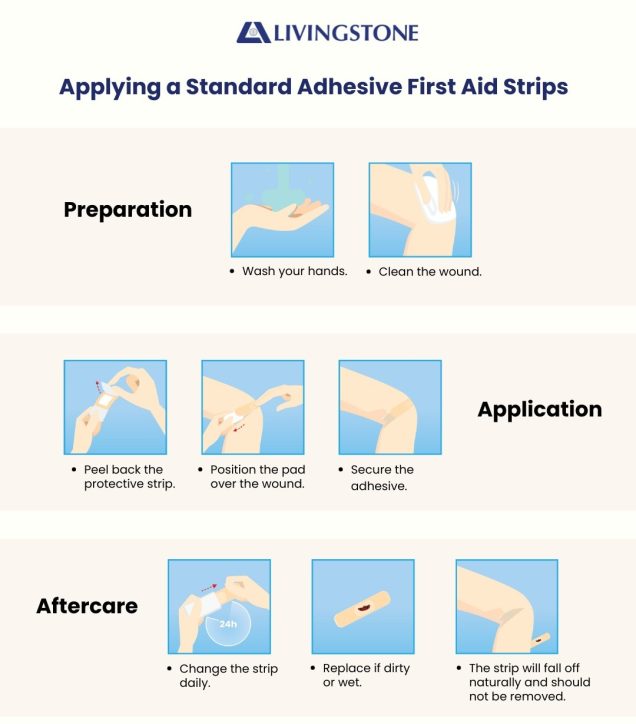First aid strips are one of the most commonly used items in any home, workplace, or healthcare setting. Compact, sterile, and easy to apply, they provide an immediate barrier between a wound and potential sources of infection. Whether it is a small cut in the kitchen, a scrape on the playground, or a blister from new shoes, having the right type of first aid strip can make a significant difference in wound healing and comfort.
This guide explores the types of first aid strips available, how they differ from bandages or plasters, their water-resistant properties, and what you need to know about their shelf life.
Types of First Aid Strips for Different Wounds
Not all wounds are the same, which is why first aid strips come in a wide variety of shapes, sizes, and materials. Choosing the right strip ensures better wound coverage, faster healing, and greater protection against infection.
- Standard fabric strips: These are versatile and breathable, suitable for everyday minor cuts and scrapes. Their flexibility allows them to conform to areas like fingers and knees
- Plastic strips: Often transparent and less flexible than fabric, plastic strips are useful for low-movement areas. They provide a strong adhesive hold and allow quick visual inspection of the wound.
- Cushioned or padded strips: These are designed for blisters, friction wounds, or cuts that need extra protection. The cushioning helps absorb pressure, making them popular for foot care.

- Specialty shapes: Finger strips, knuckle strips, and butterfly closure strips are tailored for areas where movement is high or where standard shapes may peel off too quickly.
- Hypoallergenic strips: For sensitive skin, hypoallergenic adhesives reduce the risk of irritation, making them ideal for children or those with known skin sensitivities.
- Waterproof and breathable strips: Designed to stay in place during showering, swimming, or heavy activity, these provide reliable wound coverage in moist environments.
The right first aid strip depends on the wound’s location, size, and the level of protection needed.
First Aid Strips vs. Bandages and Plasters
While the terms strip, bandage, and plaster are often used interchangeably, there are key distinctions worth noting.
- First aid strips: Pre-cut, sterile, adhesive-backed products with an absorbent pad in the centre. They are best for small to medium wounds and are designed for quick, convenient application.
- Bandages: A broader category that includes adhesive strips, but also larger fabric or elastic wraps used to secure dressings, support joints, or apply pressure. Bandages are not always sterile.
- Plasters: In many regions, especially the UK and parts of Australia, “plaster” is the common word for adhesive strips. However, plasters may also refer to medicated versions that contain antiseptic or hydrocolloid gel.
In short, first aid strips are a specific type of bandage, designed for convenience, single-use protection, and everyday cuts and grazes.
Wound Closure Strips
Wound closure strips, often referred to as butterfly bandages, are a specialised type of first aid strip designed to close small but deeper cuts with straight edges. Unlike standard adhesive strips, their purpose is to gently pull the wound edges together, supporting faster healing and helping to minimise scarring. They are particularly useful when a wound does not require stitches but still needs additional support to stay closed. Wound closure strips naturally detach after several days and should not be forcibly removed, making them a safe and effective option for certain minor lacerations.

Waterproof and Water-Resistant Properties
One of the most common questions around first aid strips is whether they can withstand water. The answer depends on the product:
- Waterproof strips form a complete barrier, keeping out moisture even during bathing or swimming. They typically feature a thin film backing that prevents water entry while still allowing some airflow.
- Water-resistant strips repel light splashes and sweat but are not suitable for extended submersion. They are better for daily activity where the wound may come into brief contact with water.
Water-resistant strips repel light splashes and sweat but are not suitable for extended submersion. They are better for daily activity where the wound may come into brief contact with water.
Shelf Life and Signs of Ineffectiveness
Like most medical supplies, first aid strips have an expiry date. Typically, their shelf life ranges from three to five years, depending on storage conditions. After this period, the adhesive may weaken, the sterile barrier may no longer be guaranteed, and the absorbent pad may deteriorate.
You can tell a first aid strip is no longer effective if:
- The adhesive backing feels dry, brittle, or does not stick well.
- The sterile packaging is damaged, torn, or has become discoloured.
- The strip appears yellowed, hardened, or has an unusual odour.
To maximise shelf life, store strips in a cool, dry place, away from direct sunlight and humidity. A well-organised first aid kit should be checked annually to remove expired products and replenish supplies.
The Importance of Having First Aid Strips Ready
Keeping a reliable stock of first aid strips in your home, car, and workplace ensures you can respond immediately to minor injuries. Quick application reduces the risk of infection, speeds up recovery, and provides comfort and reassurance.

For workplaces in particular, maintaining adequate first aid supplies is not just practical but also a compliance requirement under Safe Work Australia guidelines. Similarly, families can benefit from advice on wound care and injury prevention provided by Healthdirect Australia, a government-backed health information resource.
Final Thoughts
First aid strips may seem like a small item, but they play a vital role in wound management. By understanding the different types available, how they differ from other dressings, and their proper storage, you can ensure you are always prepared to care for everyday injuries quickly and effectively.
A well-stocked first aid kit, refreshed regularly, can be the difference between a wound that heals smoothly and one that leads to complications.
References
- Healthdirect Australia. (2023) Wound care. Healthdirect. Available at: https://www.healthdirect.gov.au/ (Accessed: 22 September 2025).
- Safe Work Australia. (2024) First aid in the workplace. Safe Work Australia. Available at: https://www.safeworkaustralia.gov.au/ (Accessed: 22 September 2025).
